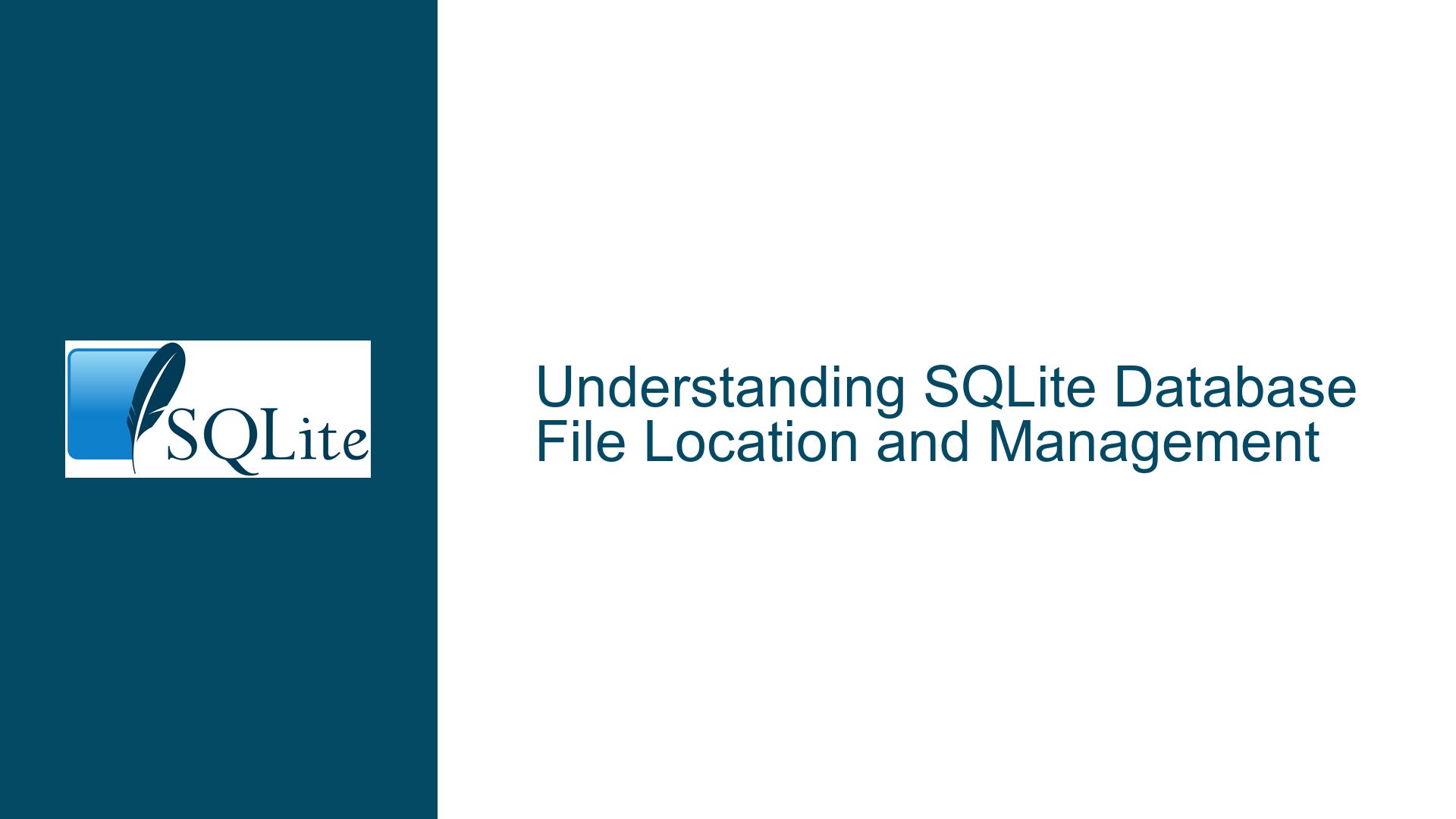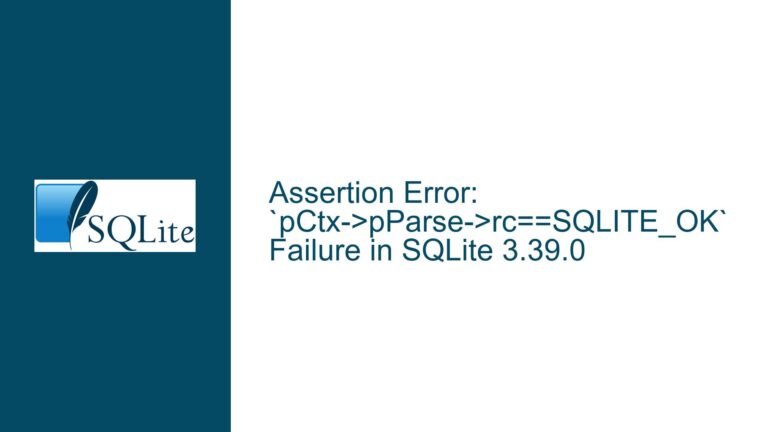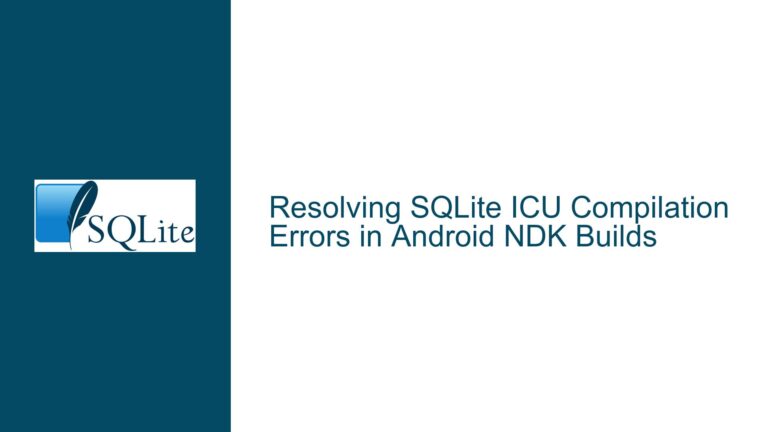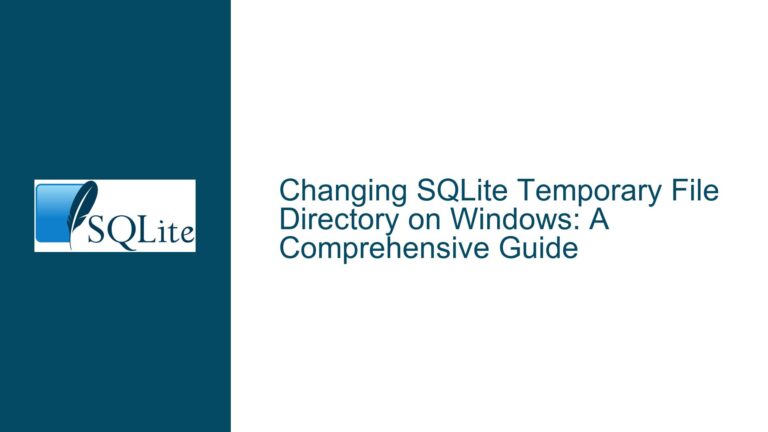SQLite Database File Location and Management
Issue Overview: SQLite Database File Location and Persistence
When working with SQLite, one of the most fundamental aspects to understand is how and where the database files are stored. SQLite is a serverless, self-contained database engine that stores the entire database in a single file on disk. However, the location and persistence of this file depend on how the SQLite command-line interface (CLI) is invoked and the commands used during the session. A common issue arises when users create tables or insert data without specifying a database file, leading to confusion about where the data is stored and how to manage it.
SQLite operates in two primary modes: in-memory databases and persistent databases. An in-memory database exists only during the session and is lost once the session ends, while a persistent database is stored in a file on disk and can be accessed across sessions. The confusion often stems from not specifying a file when starting the SQLite CLI, which defaults to an in-memory database. This can lead to situations where users create tables and insert data, only to find that the data is not persisted after the session ends.
Understanding the nuances of SQLite’s file management is crucial for effective database administration. This includes knowing how to specify the database file location, how to switch between in-memory and persistent databases, and how to manage multiple database files within a single session. Additionally, understanding the commands available in the SQLite CLI, such as .open, .save, and .databases, is essential for managing database files effectively.
Possible Causes: Why Database Files May Not Be Found or Persisted
The primary cause of the issue where database files are not found or data is not persisted is the use of an in-memory database instead of a persistent one. This typically occurs when the SQLite CLI is started without specifying a database file. In such cases, SQLite defaults to an in-memory database, which is temporary and does not create a file on disk. Any tables created or data inserted during this session will be lost once the session ends.
Another potential cause is the misunderstanding of the .databases command output. When using the .databases command, SQLite displays information about the currently open databases. If no file is specified when starting the CLI, the main database will be listed as an in-memory database, and no file path will be shown. This can lead to confusion, especially for users who are not familiar with the distinction between in-memory and persistent databases.
Additionally, the use of outdated versions of SQLite can contribute to the issue. Older versions of SQLite may lack certain commands, such as .save, which are essential for managing database files. For example, the .save command, which allows users to save an in-memory database to a file, was added in a later version of SQLite. Users running older versions may not have access to this command, making it more difficult to manage database files effectively.
Finally, the issue can also arise from incorrect usage of SQLite commands. For example, users may attempt to use the .save command without specifying a file name, or they may use the .open command incorrectly, leading to unexpected behavior. Understanding the correct usage of these commands is essential for managing database files effectively.
Troubleshooting Steps, Solutions & Fixes: Managing SQLite Database Files
To effectively manage SQLite database files and ensure data persistence, it is essential to follow a series of steps and best practices. These steps include specifying the database file when starting the SQLite CLI, using the correct commands to manage database files, and ensuring that the correct version of SQLite is being used.
1. Specifying the Database File When Starting the SQLite CLI
The most straightforward way to ensure that a database file is created and data is persisted is to specify the database file when starting the SQLite CLI. This can be done by providing the file name as an argument when invoking the sqlite3 command. For example, to create a database file named Test.db in the C:\MyFolder directory, the following command can be used:
sqlite3 C:\MyFolder\Test.db
This command will create the Test.db file in the specified directory if it does not already exist. Any tables created or data inserted during the session will be stored in this file, ensuring that the data is persisted across sessions.
2. Using the .open Command to Switch Between Databases
If the SQLite CLI is started without specifying a database file, it defaults to an in-memory database. However, it is possible to switch to a persistent database using the .open command. The .open command allows users to open a specified database file or create a new one if it does not exist. For example, to switch to a persistent database file named Test.db in the C:\MyFolder directory, the following command can be used:
.open C:\MyFolder\Test.db
This command will open the specified database file, and any subsequent operations will be performed on this file. If the file does not exist, it will be created. This is particularly useful for users who accidentally start the SQLite CLI without specifying a database file and want to switch to a persistent database without losing their current session.
3. Using the .save Command to Save an In-Memory Database to a File
In cases where the SQLite CLI is started without specifying a database file, and tables or data have already been created in an in-memory database, the .save command can be used to save the in-memory database to a file. The .save command writes the contents of the current in-memory database to the specified file. For example, to save the in-memory database to a file named Test.db in the C:\MyFolder directory, the following command can be used:
.save C:\MyFolder\Test.db
This command will create the specified file and write the contents of the in-memory database to it. Once the file is saved, it can be opened in subsequent sessions using the .open command or by specifying the file when starting the SQLite CLI.
4. Understanding the .databases Command Output
The .databases command provides information about the currently open databases. When using this command, it is essential to understand the output to determine whether the database is in-memory or persistent. The output of the .databases command includes the following columns:
- Seq: The sequence number of the database.
- Name: The name of the database (e.g.,
main,temp). - File: The file path of the database.
If the File column is empty for the main database, it indicates that the database is in-memory. If a file path is shown, it indicates that the database is persistent and stored in the specified file. Understanding this output is crucial for managing database files effectively.
5. Ensuring the Correct Version of SQLite is Being Used
As mentioned earlier, the availability of certain commands, such as .save, depends on the version of SQLite being used. It is essential to ensure that the correct version of SQLite is being used to take advantage of all available features. The latest version of SQLite can be downloaded from the official SQLite website. To check the current version of SQLite being used, the following command can be executed:
sqlite3 --version
This command will display the version of SQLite currently installed. If an older version is being used, it is recommended to upgrade to the latest version to ensure access to all available commands and features.
6. Managing Multiple Database Files Within a Single Session
SQLite allows users to work with multiple database files within a single session by attaching additional databases. The ATTACH DATABASE command can be used to attach another database file to the current session. For example, to attach a database file named AnotherDB.db in the C:\MyFolder directory, the following command can be used:
ATTACH DATABASE 'C:\MyFolder\AnotherDB.db' AS another_db;
Once attached, the tables in the attached database can be accessed using the another_db prefix. For example, to query a table named MyTable in the attached database, the following command can be used:
SELECT * FROM another_db.MyTable;
This feature is particularly useful for users who need to work with multiple database files simultaneously.
7. Best Practices for Managing SQLite Database Files
To avoid issues related to database file location and persistence, it is essential to follow best practices when working with SQLite. These best practices include:
- Always specify a database file when starting the SQLite CLI: This ensures that the database is persistent and stored in a file on disk.
- Use the
.opencommand to switch between databases: This allows users to switch to a persistent database without losing their current session. - Use the
.savecommand to save in-memory databases to a file: This ensures that data created in an in-memory database is not lost when the session ends. - Regularly check the
.databasescommand output: This helps users understand whether they are working with an in-memory or persistent database. - Keep SQLite up to date: This ensures access to the latest features and commands, such as
.save.
By following these best practices, users can effectively manage SQLite database files and ensure data persistence across sessions.
8. Common Pitfalls and How to Avoid Them
There are several common pitfalls that users may encounter when working with SQLite database files. These pitfalls include:
- Starting the SQLite CLI without specifying a database file: This defaults to an in-memory database, leading to data loss when the session ends. To avoid this, always specify a database file when starting the SQLite CLI.
- Misunderstanding the
.databasescommand output: This can lead to confusion about whether the database is in-memory or persistent. To avoid this, regularly check the.databasescommand output and ensure that a file path is shown for themaindatabase. - Using outdated versions of SQLite: This can lead to missing commands, such as
.save. To avoid this, regularly update SQLite to the latest version. - Incorrect usage of SQLite commands: This can lead to unexpected behavior. To avoid this, refer to the official SQLite documentation and use the
.helpcommand to understand the correct usage of each command.
By being aware of these common pitfalls and taking steps to avoid them, users can effectively manage SQLite database files and ensure data persistence.
9. Advanced Techniques for Managing SQLite Database Files
For advanced users, there are several techniques that can be used to manage SQLite database files more effectively. These techniques include:
- Using the
.backupcommand to create database backups: The.backupcommand allows users to create a backup of the current database to a specified file. For example, to create a backup of the current database to a file namedBackup.dbin theC:\MyFolderdirectory, the following command can be used:
.backup C:\MyFolder\Backup.db
This command creates a backup of the current database, which can be used to restore the database in case of data loss.
- Using the
.restorecommand to restore a database from a backup: The.restorecommand allows users to restore a database from a backup file. For example, to restore a database from a backup file namedBackup.dbin theC:\MyFolderdirectory, the following command can be used:
.restore C:\MyFolder\Backup.db
This command restores the database from the specified backup file, overwriting the current database.
- Using the
.dumpcommand to export the database schema and data: The.dumpcommand allows users to export the schema and data of the current database to a SQL script. For example, to export the schema and data to a file namedDump.sqlin theC:\MyFolderdirectory, the following command can be used:
.output C:\MyFolder\Dump.sql
.dump
This command exports the schema and data to the specified file, which can be used to recreate the database on another system.
- Using the
.readcommand to execute SQL scripts: The.readcommand allows users to execute SQL scripts from a file. For example, to execute a SQL script namedScript.sqlin theC:\MyFolderdirectory, the following command can be used:
.read C:\MyFolder\Script.sql
This command executes the SQL script, allowing users to automate database operations.
By using these advanced techniques, users can manage SQLite database files more effectively and ensure data persistence across sessions.
10. Conclusion
Managing SQLite database files effectively is essential for ensuring data persistence and avoiding common pitfalls. By understanding the distinction between in-memory and persistent databases, using the correct commands to manage database files, and following best practices, users can ensure that their data is stored securely and can be accessed across sessions. Additionally, by keeping SQLite up to date and using advanced techniques, users can take full advantage of the features available in SQLite and manage their database files more effectively.
In summary, the key to managing SQLite database files lies in understanding how SQLite handles file storage, using the correct commands to manage files, and following best practices to avoid common pitfalls. By following the steps and techniques outlined in this guide, users can ensure that their SQLite databases are stored securely and can be accessed across sessions, providing a reliable and efficient solution for their data storage needs.






